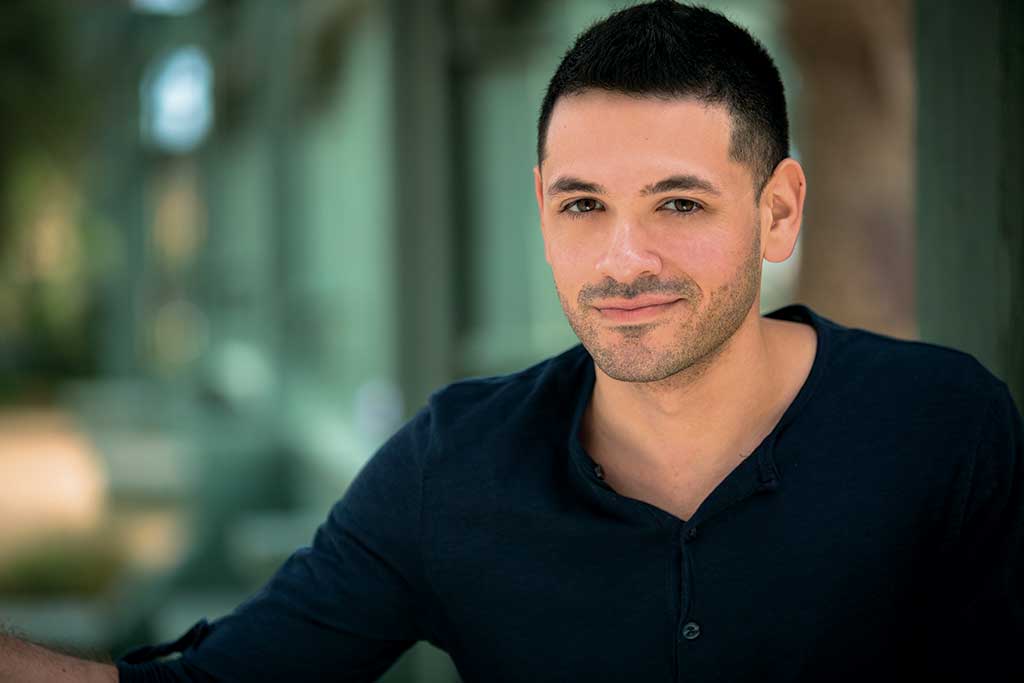For the best view of the city, take a ride on the funicular railway or cable car to Monserrate, a lovely hilltop sanctuary that offers inspiring vistas; the tiny chapel on the top attracts pilgrims, who walk to the top of the hill on Sundays. You can have lunch or dinner at either of two lovely restaurants at the peak: Casa San Isidro, which serves French cuisine, and Casa Santa Clara, which specializes in traditional Colombian dishes. Be sure to check the weather forecast before visiting Monserrate, since dense smog or fog can cancel out the view on some days.

Street Art
Also worth a visit are the Museo Nacional (National Museum), which recounts the nation’s history and culture through art, artifacts, and historic exhibits (set interestingly inside a historic former prison), and the Casa Museo Quinta de Bolivar, the one-time home of Simon Bolivar, the man who liberated this part of South America from Spanish rule. The home is surprisingly small but well maintained and furnished with period pieces; the gardens are especially beautiful.
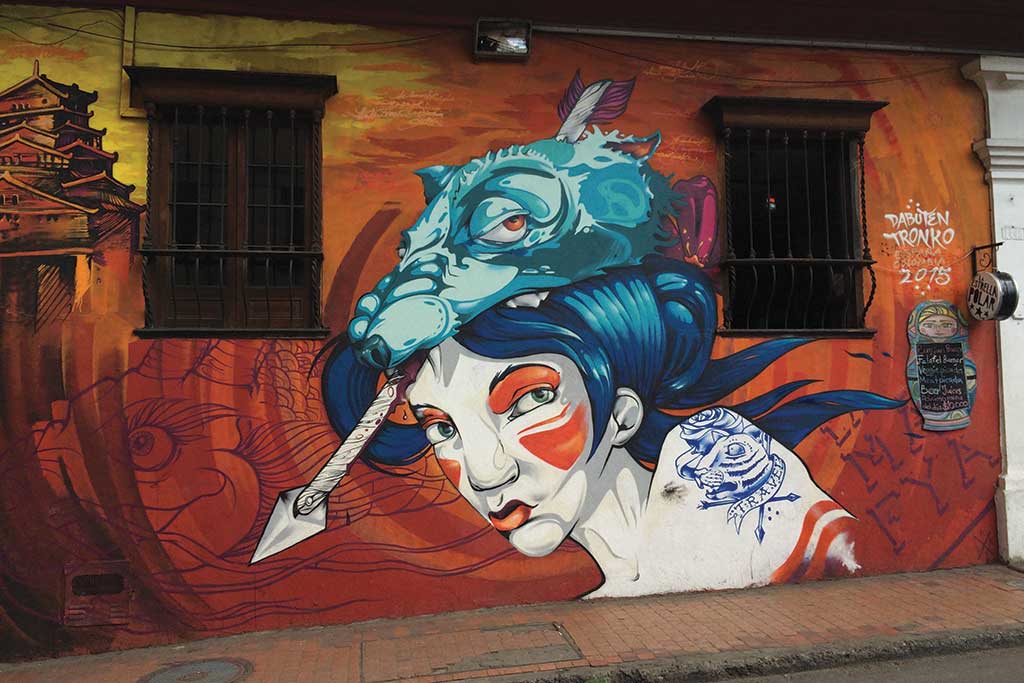

Street Art
Art lovers should make time to visit one or two additional neighborhoods: La Macarena and San Felipe, both of which are dotted with cutting-edge private art galleries. The more attractive La Macarena offers additional diversions, in the form of restaurants and small shops.
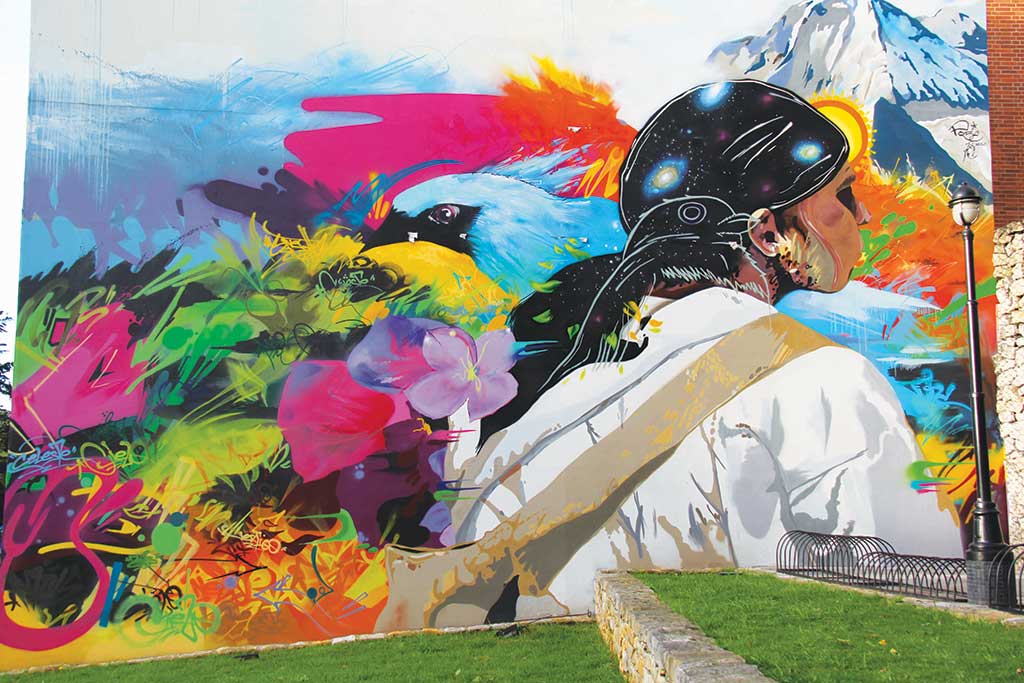

Street Art
Hardcore fans of street art and graffiti probably already know that Bogota is one of the hemisphere’s top destinations for this type of urban expression; in fact, graffiti and street artists from other countries travel here to contribute to the city’s open-air canvases. For a fascinating overview of these public displays of creativity, join Bogota Graffiti Tour, which leads free walking tours of street art in La Candelaria as well as customized tours, or contact Federico Ruiz, an art dealer who leads graffiti and art tours that tell the political and creative history of the city. The advantage of doing a customized public art tour is that you can visit more far-flung neighborhoods; one of the most rewarding is Santa Fé, which was in decades past an upper-class neighborhood. Today the barrio’s more run-down buildings provide the perfect canvas for an impressive array of artwork, especially on Calle 24, which is something like an open-air art gallery. A stop at Café del Fondo for coffee is a popular stop here too.
Bogota also plays host to a variety of exciting annual events. Art lovers might consider attending ArtBo, an art festival that takes place in October. And Bogota’s LGBT pride parade takes place in June. But regardless of when you visit, it’s easy to tap into the city’s gay vibe.
Bogota’s sophisticated and diverse dining scene offers many treats for the taste buds, as well as excitement for the other senses. A popular stop for first-time visitors (as well as locals) is Andres DC, a festive and locally famous restaurant known as much for its live music and costumed entertainers as it is for the tasty Colombian cuisine. Don’t visit here unless you’re in the mood for a party; the staff interacts quite a bit with patrons, and you can even dance. For a quieter, hip ambiance consider Local by Rausch, which also serves Colombian specialties in a stylish ambiance.
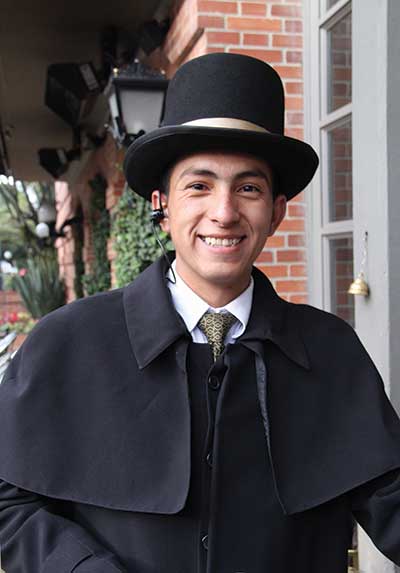

Doorman at Sofitel Victoria Regia
For a mouthwatering overview of Bogota’s culinary scene, consider a tour with Foodies Colombia, a company that offers a fun-andfilling Chapinero Bites food tour of the city’s gayest neighborhood. Among the hottest new eateries here are Amen Ramen, which serves ramen noodles, Taiwanese street food, and Vietnamese ribs in a chicbut-casual ambiance. Another great choice is Mesa Franca, which is set in a former home and serves tasty buñuelos de yucca (fried dough ball made with cassava), artisanal soda pop, and classic cocktails. Also noteworthy and featured on some of their itineraries is Indio, a hip restaurant located on the first floor of an apartment building. The retro-cool style features mismatched chairs and plates, while the cuisine benefits from a brick oven that produces delicious pizzas.
For lighter fare, consider a stop at Mistral, a casual, French-style bakery and café, where the melt-in-your-mouth croissants are worth a trip. Beer connoisseurs should plan on a visit to El Mono Bandido, a cool bar with light meals and an array of artisanal brews.
Foodies Colombia also offers a food tour that starts at Plaza de Mercado de Paloquemao, a bustling food market with lots of opportunities to sample mouthwatering fresh bread (the pan de yucca, made with cassava, is especially delicious) and to sip avena (a sweet oatmeal drink served chilled). Visitors can also taste exotic fruits like gulupa (a type of passion fruit), curuba (banana passion fruit), feijoa (a species of flowering plant called Acca sellowiana), and various types of potatoes. Additional must-tries at the market include freshly made cheeses and the tamales tolimense (tamales filled with chicken and pork).
The market provides a surprisingly in-depth look at pre-Hispanic and Spanish ingredients and traditions, some of which fell out of favor but are now enjoying renewed popularity. “We as cooks are looking to reintroduce traditional ingredients in our meals,” said María Gutiérrez de Piñeres, the Foodies Colombia tour guide. “Talking with people in the market is part of the experience. You can buy a lot of these things in supermarkets in Bogota, but the history behind everything is important.”
After the market, the tour heads to La Escuela Taller de Cocina Internacional, a culinary school set in a beautiful historic building in the La Candelaria district. There, we lunched on tasty ajiaco (a hearty stew with chicken and corn prepared by a staff of culinary students), before heading to a kitchen to test our skill at preparing our own dessert.
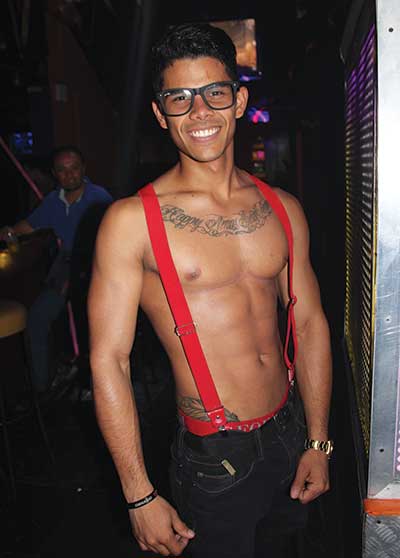

Waiter at Anónimos Bar
New York City has Hell’s Kitchen. Mexico City has the Zona Rosa, and Bogota has Chapinero. The central part of Chapinero, the gayest part, is gritty, not fancy, and not pretty. You won’t find shady, tree-lined streets or irresistible architecture, but you will find rainbow-colored crosswalks and more LGBT businesses than you can count on two hands with bars, clubs, shops, and restaurants among the offerings. Just a few blocks away, in Chapinero Alto, you’ll find a quieter ambiance, more attractive homes, and hipper small shops and restaurants.
The heart of the neighborhood centers around the Lourdes church, which sits on a square, that, along with Hippie Park, is among the few places with shade trees in the neighborhood. A panoply of cheap restaurants surrounds the square, while the Lourdes shopping center, across the street, is a rather gay-oriented mall that has multiple tiny shops selling men’s fashion, including risqué underwear and swimwear that might be perfect if your next stop is the beach-lined city of Cartagena. Several small sex shops dot the hallways here, too along with a variety of non-chain fast-food restaurants that sit on the second floor. This isn’t the most upscale, creative or stylish place to shop, but it’s the heart of the gayborhood.
Chapinero’s rainbow-infused gay side truly comes alive after dark, and especially on weekends. Square one for any gay visitor is Theatron; there’s nothing else like it in the hemisphere. Since opening in 2002 in an abandoned movie theater, the massive nightclub has grown to include more than a dozen separate sections.
This mega-nightclub is always introducing new concepts, entertainment, and venues. “The idea of Theatron has always been to offer something new to the public,” said Fernando Koral, the general producer who’s responsible for shows and other visuals at the club. “This is a place where people come to have a good time, regardless of their social status or whether they’re gay or straight.”
Theatron is so big, in fact, that they post a board showing which venues are open on which nights, and what the ambiance is like. Saturday is the one night of the week when all sections are open, and the admission fee (which is less than $20) includes open bar for select drinks for part of the evening. Patrons are given a plastic cup at the entrance, and that serves as their refillable key to the open bar.
Among the venues here is Lotus, a pleasant rooftop bar, partly open-air, with DJs, go-go boys, and a dance floor that gets crowded with revelers who enjoy the mix of pop, electronica, and reggaeton music. Also large in scale is Templo, an area designed to resemble the inside of a church, which plays fast-paced music in Spanish. Berlin Bar specializes in rock music and has pool tables, while Epoca focuses on pop from the 1970s, 80s, and 90s. Eva is designed for women only, and La Cantina is a small space designed to look a bit like a Mexican cantina. Another rooftop area, Plaza Rosa, feels a bit like Main Street at an amusement park, with various façades leading into different sections. There’s even a food vendor on site. It’s no wonder that some people call Theatron a “Disney World for gay people.”
There are more than a dozen smaller bars and dance clubs within walking distance in the neighborhood. Anónimos is pretty much the most consistently reliable venue for gay men throughout the week. With its rather basic black walls and no specificed dance floor, the venue nevertheless packs in a largely male crowd of varying ages. The crowds keep moving as the DJs play all kinds of music in English and Spanish, and there’s never a cover. The circular bar in the middle of the room makes it easy to take a stool and watch the scene. Tuesday is “Martes de Solteros,” when the waiters go shirtless. Across the street from Anónimos sits Abisinia, a tiny bar that belongs to the same owner. This attractive little place is dotted with tables and chairs that make it a relaxed place to spend time chatting with friends. Also good for a night out with friends, or a romantic partner is Estación Café, a relaxed, small venue with tables and seating on two floors. Its wood construction and fireplace exude the feel of a country house, while the electronic food and drink menu, and call button for service, are decidedly big-city, of course, as are the extensive lists of cocktails and food, which includes cordon bleu and filet mignon. There are three locations in Bogota; the one in Chapinero on Calle 62 is the best. A fourth, smaller venue, Estación del Shot, opened in May 2016 on Calle 60 closer to the other gay bars.
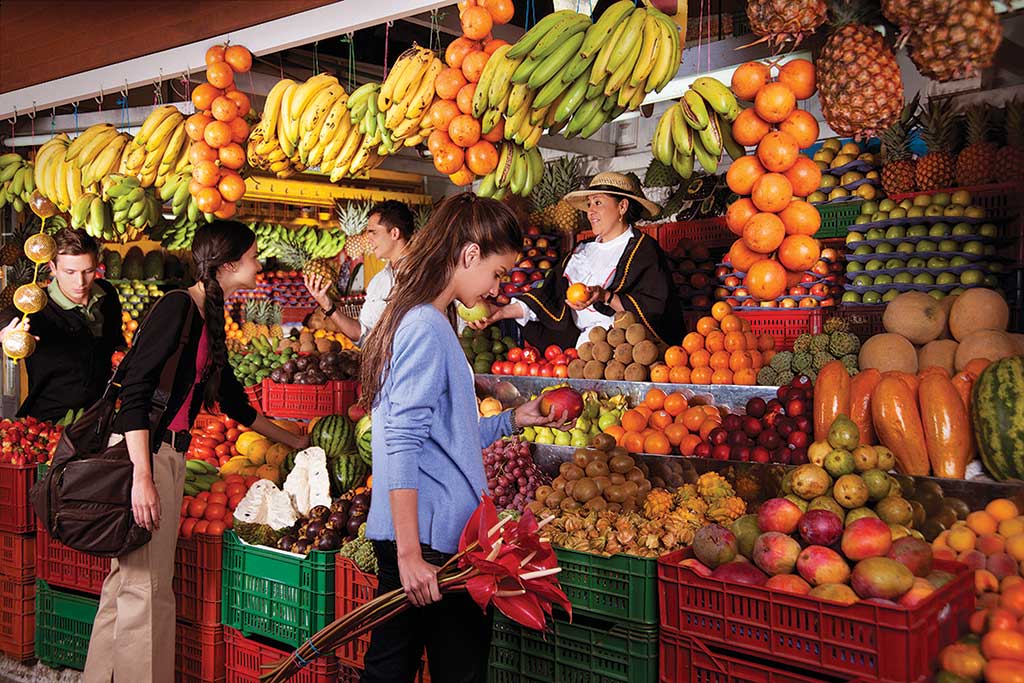

Plaza de Mercado de Paloquemao
For somewhat campy fun on a small scale, peek into El Perro y la Calandria, a compact, two-story bar that’s devoted mostly to retro, Spanish-language pop music from decades past. It’s a fun place to indulge and watch dramatic videos of various performers from around Latin America and Spain. This type of music is called “musica para planchar”—a reference to the fact that people listen to soapy, romantic ballads when they iron their clothes. El Perro y la Calandria also hosts karaoke on some nights.
There are other places tucked away on side streets or on second floors. It’s best to ask locals for their personal favorites, and choose the ones the best fit your style and preferences. Wandering can lead to interesting discoveries. While out with one friend, we came across Brokeback Mountain, a second-floor bar with hodgepodge décor that’s mildly reminiscent of the US West, thanks to its movie theme. The bar serves a menu of light meals and a variety of cocktails, and hosts karaoke on some nights.
Several gay clubs and bars are outside of Chapinero. Among the most popular is El Mozo, in the upscale Zona T. Long lines snake down the block on weekends here, and there are two dance floors: one that usually plays electronica and has lots of flashy lights; go-go boys, and other performers. On a more darkly lit top floor, Spanish-language music like reggaeton is the preferred musical style. Sundays are especially good since that is when they open the rooftop terrace. Bogota is home to so many gay bars and clubs that you will likely not be able to visit them all, even if you try, but that’s OK. It will give you a reason to visit again.


